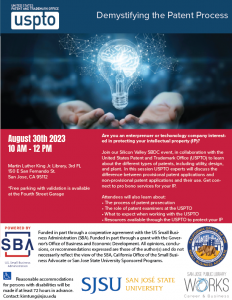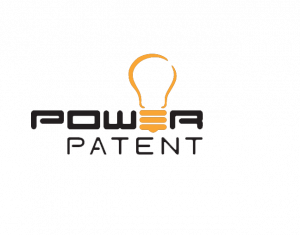
San Jose SBDC USPTO Seminar on Demystifying the Patent Process and How To Create Quick Provisional Applications
San Jose SBDC, San Jose State University & USPTO Seminar on Patent Process and converting invention disclosures into Provisional Applications
SANTA CLARA, CA, UNITED STATES, August 30, 2023/EINPresswire.com/ -- Join the Silicon Valley SBDC hosted by San Jose State University, in collaboration with the United States Patent and Trademark Office (USPTO) to learn about the different types of patents, including utility, design, and plant. In this seminar, USPTO experts will discuss the difference between provisional patent applications and non-provisional patent applications and their use as intellectual property. Attendees will learn about software-assisted patent filing and cost saving strategies from Patent Attorney, Bao Tran.
Featured Presenters:
Brent Fairbanks is a Primary Patent Examiner at the United States Patent and Trademark Office (USPTO) with a focus on data processing of sensor measurements. He serves as an Assistant Outreach Coordinator for the Western Regional Office, supporting programs for inventors, entrepreneurs, and other communities in the western United States along with K-12 STEM activities.
Bao Tran is a seasoned Patent Attorney with over 20 years of experience in patent filing, prosecution, licensing and monetization. He has architected patent portfolios for many startups that went public such as Align Technologies and Shutterfly.
PowerPatent's generative AI is advantageous for startups and university transfer offices in expediting first-to-file status for their inventors. University researchers can simply paste their articles into PowerPatent to create provisional applications before submitting the paper for publication. The process for converting a Magazine Paper Submission into a Provisional Patent Application with PowerPatent is simple:
Upload and Import: Begin by uploading the magazine paper submission that contains the inventors' innovative research findings. Inventors can directly import the content from the Word document or provide a link to the online version such as Google Doc.
AI Analysis: PowerPatent's AI engine carefully analyzes the content of the magazine paper submission. It identifies and extracts key technical concepts, novel ideas, and unique elements that could potentially form the basis of a patent application.
Content Extraction: The AI engine selectively extracts relevant sections from the magazine paper, such as problem statements, methodologies, experimental results, and conclusions. These sections serve as the foundation for a provisional patent application.
AI-Generated Drafting: Leveraging the extracted content, PowerPatent's AI generates a preliminary draft of the provisional patent application. This draft includes descriptions of the invention, technical aspects, and potential claims.
User Review and Customization: Review the AI-generated draft to ensure its accuracy and alignment with the invention. Inventors can easily edit, modify, or add specific technical details to ensure that the provisional application accurately represents the innovation.
Technical Language Enhancement: The AI engine ensures that the language used in the provisional application aligns with patent standards and legal requirements. It helps convert complex technical jargon into clear, concise, and legally sound descriptions.
Figures and Diagrams Integration: If the magazine submission includes relevant figures, diagrams, or illustrations, PowerPatent's platform allows users to integrate these visuals seamlessly into the provisional application.
Collaboration and Feedback: If desired, inventors can collaborate with colleagues or legal experts within PowerPatent's platform to seek feedback and suggestions for refining the draft and claims.
Auto-Generated Sections: PowerPatent's AI can also automatically generate sections such as the abstract, background, and summary of the invention based on the content of the magazine paper.
Final Review: At the end of the process, perform a final review to ensure accuracy, completeness, and alignment with the innovation.
Export and Filing: Once the inventors are confident with the provisional patent application, PowerPatent provides options to export the application in a format suitable for submission to the relevant patent office and the attorney or inventor can then proceed with the filing process.
By using PowerPatent's AI-driven platform, the process of converting a magazine paper submission into a provisional patent application becomes streamlined, efficient, and accurate. The platform's AI technology eliminates the need for extensive manual translation of technical content and helps researchers and inventors seamlessly bridge the gap between research publications and intellectual property protection. Benefits of Converting Scientific Publications into Ready-to-File Provisional Applications with PowerPatent may include the following:
Speed to Protection: Converting scientific publications into provisional patent applications with PowerPatent significantly reduces the time required to transform groundbreaking research into protected intellectual property. This speed-to-protection advantage ensures that novel ideas are safeguarded promptly.
Preservation of Priority: In the fast-paced world of research, early disclosure is common. By converting publications into provisional applications, researchers can establish an early priority date and prevent potential loss of patent rights due to prior disclosures.
Efficient Patent Drafting: PowerPatent's AI-driven platform streamlines the conversion process by automatically generating patent application content from scientific publications. This efficient drafting minimizes the need for extensive manual translation of technical content.
Enhanced Patent Quality: PowerPatent's AI ensures that the converted provisional applications are comprehensive and accurately capture the essence of the scientific publication. This enhances the quality of the patent applications and their chances of successful grants.
Simplified Process: Researchers and inventors can seamlessly convert their scientific findings into provisional applications without requiring an in-depth understanding of patent law or drafting techniques. This simplification encourages broader participation in the patenting process.
Protection During Evaluation: Many research findings undergo further evaluation for commercial viability. By filing a provisional application, researchers can secure protection for their work during this evaluation phase, providing more time to assess its potential.
Strategic Portfolio Management: Converting scientific publications into provisional applications allows research institutions to strategically manage their patent portfolios. They can prioritize which research findings to protect and assess their commercial potential before committing to full patent applications.
Flexibility for Future Claims: Provisional applications provide a foundation for future utility or non-provisional applications. Researchers can continue refining and developing their inventions during the provisional's one-year period, allowing for more comprehensive claims in subsequent filings.
Monetization Opportunities: With a protected provisional application, researchers and institutions can confidently explore licensing, collaboration, or commercialization opportunities, enhancing their ability to monetize their intellectual property.
Alignment with Research Goals: Converting publications into provisional applications aligns research efforts with intellectual property goals. Researchers are incentivized to consider the patent potential of their work early in the process, fostering a culture of innovation.
Cost-Effective Strategy: Filing provisional applications is often more cost-effective than filing full utility applications. This approach allows researchers and institutions to secure an early priority date without incurring the costs associated with a full patent filing.
Elevated Reputation: Demonstrating the ability to protect and commercialize research through patent applications enhances the reputation of both individual researchers and research institutions, attracting potential collaborators and funding opportunities.
In conclusion, PowerPatent empowers researchers and research institutions to seamlessly convert scientific publications into provisional patent applications. This process offers benefits such as rapid protection, preservation of priority, and enhanced patent quality, while also promoting efficient portfolio management and strategic alignment with research goals. By leveraging PowerPatent's AI-driven platform, researchers can navigate the complex patent landscape with confidence and unlock the value of their research through intellectual property protection.
Benefits for University Tech Transfer Offices with PowerPatent:
Accelerated Patent Drafting: PowerPatent streamlines the patent drafting process, allowing tech transfer offices to quickly transform complex technical information into well-structured patent applications. This efficiency reduces time-to-file, ensuring intellectual property protection is secured promptly.
Enhanced Productivity: With AI-assisted drafting, tech transfer teams can focus more on strategic tasks such as evaluating inventions' commercial potential and engaging with industry partners, rather than spending excessive time on drafting intricate patent applications.
Consistency and Quality: PowerPatent ensures a consistent approach to patent drafting, reducing the chances of errors and omissions. This consistency enhances the quality of patent applications, increasing the likelihood of successful grants.
Ease of Collaboration: PowerPatent promotes collaboration among inventors, legal teams, and external partners. The platform's shared workspace allows real-time collaboration and feedback, fostering a seamless exchange of ideas and expertise.
Cost Efficiency: The efficient drafting process and reduced need for extensive manual editing translate into cost savings for university tech transfer offices. This cost efficiency is particularly valuable for institutions with limited budgets.
Empowered Inventors: PowerPatent's user-friendly interface empowers inventors to actively contribute to the drafting process. This engagement not only ensures accurate documentation of their ideas but also builds a sense of ownership in the patenting process.
Strategic Decision-Making: By streamlining the drafting process, PowerPatent frees up valuable resources that can be redirected towards evaluating inventions' commercial viability, exploring licensing opportunities, and making informed strategic decisions.
Adaptability and Learning: As PowerPatent's AI continuously learns and improves, it adapts to specific university requirements, legal nuances, and patent office preferences. This adaptability ensures a tailored approach to each patent application.
IP Portfolio Growth: With faster drafting and enhanced collaboration, tech transfer offices can manage larger inventories of patent applications, expanding the institution's intellectual property portfolio and potential revenue streams.
Future-Proofing: By integrating AI-powered patent drafting into their workflow, tech transfer offices position themselves as forward-thinking institutions embracing the potential of technology to drive efficiency, innovation, and impact.
In summary, PowerPatent equips university tech transfer offices with an array of advantages, from accelerated patent drafting and enhanced productivity to cost efficiency and strategic empowerment. By harnessing the capabilities of AI, tech transfer offices can navigate the patent landscape more effectively, maximizing the value of their intellectual property assets and fostering innovation within their academic communities.
Mary Kimani
PowerPatent
2342157800 ext.
email us here
Visit us on social media:
Facebook
Twitter
LinkedIn
Instagram
YouTube
TikTok
How PowerPatent IP CAD Software works
Distribution channels: Automotive Industry, Aviation & Aerospace Industry, Business & Economy, Chemical Industry, Energy Industry
Legal Disclaimer:
EIN Presswire provides this news content "as is" without warranty of any kind. We do not accept any responsibility or liability for the accuracy, content, images, videos, licenses, completeness, legality, or reliability of the information contained in this article. If you have any complaints or copyright issues related to this article, kindly contact the author above.
Submit your press release



